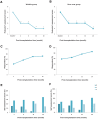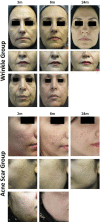Long-Term Follow-up of Autologous Fibroblast Transplantation for Facial Contour Deformities, A Non-Randomized Phase IIa Clinical Trial
- PMID: 31606970
- PMCID: PMC6791067
- DOI: 10.22074/cellj.2020.6340
Long-Term Follow-up of Autologous Fibroblast Transplantation for Facial Contour Deformities, A Non-Randomized Phase IIa Clinical Trial
Abstract
Objective: Recently, the promising potential of fibroblast transplantation has become a novel modality for skin rejuvenation. We investigated the long-term safety and efficacy of autologous fibroblast transplantation for participants with mild to severe facial contour deformities.
Materials and methods: In this open-label, single-arm phase IIa clinical trial, a total of 57 participants with wrinkles (n=37, 132 treatment sites) or acne scars (n=20, 36 treatment sites) who had an evaluator's assessment score of at least 2 out 7 (based on a standard photo-guide scoring) received 3 injections of autologous cultured fibroblasts administered at 4-6 week intervals. Efficacy evaluations were performed at 2, 6, 12, and 24 months after the final injection based on evaluator and patient's assessment scores.
Results: Our study showed a mean improvement of 2 scores in the wrinkle and acne scar treatment sites. At sixth months after transplantation, 90.1% of the wrinkle sites and 86.1% of the acne scar sites showed at least a one grade improvement on evaluator assessments. We also observed at least a 2-grade improvement in 56.1% of the wrinkle sites and 63.9% of the acne scar sites. A total of 70.5% of wrinkle sites and 72.2% of acne scar sites were scored as good or excellent on patient assessments. The efficacy outcomes remained stable up to 24-month. We did not observe any serious adverse events during the study.
Conclusion: These results have shown that autologous fibroblast transplantation could be a promising remodeling modality with long-term corrective ability and minimal adverse events (Registration Number: NCT01115634).
Keywords: Cell Therapy; Skin Rejuvenation; Wrinkle.
Copyright© by Royan Institute. All rights reserved.
Conflict of interest statement
There is no conflict of interest in this study.
Figures




References
-
- Newton VL, Mcconnell JC, Hibbert SA, Graham HK, Watson RE. Skin aging: molecular pathology, dermal remodelling and the imaging revolution. G Ital Dermatol Venereol. 2015;150(6):665–674. - PubMed
-
- Driskell RR, Watt FM. Understanding fibroblast heterogeneity in the skin. Trends Cell Biol. 2015;25(2):92–99. - PubMed
-
- Kammeyer A, Luiten RM. Oxidation events and skin aging. Ageing Res Rev. 2015;21:16–29. - PubMed
Associated data
LinkOut - more resources
Full Text Sources
Medical
